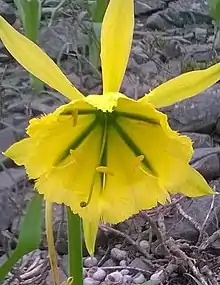Ismene amancaes
Ismene amancaes, commonly called amancae or amancay,[2][3] is a herbaceous plant species in the family Amaryllidaceae and native to the coastal hills of Peru.
| Ismene amancaes | |
|---|---|
 | |
| Flower close-up. | |
| Scientific classification | |
| Kingdom: | Plantae |
| Clade: | Tracheophytes |
| Clade: | Angiosperms |
| Clade: | Monocots |
| Order: | Asparagales |
| Family: | Amaryllidaceae |
| Subfamily: | Amaryllidoideae |
| Genus: | Ismene |
| Species: | I. amancaes |
| Binomial name | |
| Ismene amancaes | |
.svg.png.webp) | |
| Ismene amancaes is endemic to Peru[1] | |
| Synonyms[1] | |
| |
Description
I. amancaes is a species with spherical bulbs 3.5–5 cm in diameter.[4][5] The leaves are strap-shaped, 25–50 cm long and 2.5–5 cm wide, bright green.[4][5] The 2–6 yellow pedicellate flowers are borne at the end of a scape up to 33 cm long.[4] The floral tube is greenish yellow, 5–7.5 cm long, bearing at the end the tepals, which are linear to narrowly lanceolate, 6–7.5 cm long, with green tips.[4][6] The floral corona is funnel-shaped, yellow with green stripes, 5–6 cm long, 6–8.5 cm wide, bearing the stamens facing inwards.[4][6][5]
Distribution and habitat
_30.1224.jpg.webp)
Endemic to Peru, Ismene amancaes inhabits coastal hills up to 1500 m of elevation, especially near the city of Lima, as part of the lomas ecosystem.[6][7][5][8]
Chemical compounds
It is reported that I. amancaes contains the alkaloids galantamine[9] and narcissidine.[10]
History
Remains of I. amancaes have been found in archaeological sites near the city of Lima.[11]
The flowering of this species was the subject of a festival ("Festival de Amancaise") celebrated in June in Lima, until the first half of the 1800s.[12] In a place among the hills surrounding Lima, people from the city gathered annually to celebrate the flowering of the plant in a festival with music and dance, similar to May Day.[12] The festival attracted people from all classes of the society then, while a common sight was people sporting the flowers in their garments.[12]
Conservation
I. amancaes is considered an endangered species by the IUCN since 1997.[13]
References
- "Ismene amancaes (Ruiz & Pav.) Herb". Plants of the World Online. Royal Botanic Gardens, Kew. Retrieved 29 July 2023.
- Suni, Mery; Pascual, Edisson; Jara, Enoc (2011). "Desarrollo reproductivo del "amancay" Ismene amancaes (Amaryllidaceae) en su ambiente natural". Revista Peruana de Biología (in Spanish). 18 (3): 293–297.
- Soto, Marilú; Leiva, Milagros (2015). "Estudio exomorfológico y fitoquímico de los bulbos de dos especies endémicas del Perú de la familia Amaryllidaceae". Arnaldoa (in Spanish). 22 (1): 269–288.
- Cullen, James; Knees, Sabina G.; Cubey, H. Suzanne; Shaw, J. M. H. (2011). The European Garden Flora Flowering Plants: A Manual for the Identification of Plants Cultivated in Europe, Both Out-of-Doors and Under Glass. Cambridge University Press. ISBN 9780521761475.
- Weathers, John (1911). The Bulb Book. Applewood Books. p. 284. ISBN 9781429013772.
- Francis, Macbride, J. (1936). "Flora of Peru /". Fieldiana. v.13:pt.1:no.3: 671.
{{cite journal}}: CS1 maint: multiple names: authors list (link) - Goodall, David W. (2014). Evolution of Desert Biota. University of Texas Press. p. 17. ISBN 9780292740990.
- Paxton, Sir Joseph (1837). Paxton's Magazine of Botany, and Register of Flowering Plants. Orr and Smith. p. 267.
- Willaman, John James; Schubert, Bernice (1961). Alkaloid-bearing Plants and Their Contained Alkaloids. U.S. Department of Agriculture. p. 15.
- Glasby, John (2012). Encyclopedia of the Alkaloids: Volume 2 (I-Z). Springer Science & Business Media. p. 988. ISBN 9781461587293.
- Browman, David L. (1978). Advances in Andean Archaeology. Walter de Gruyter. pp. 110, 115. ISBN 9783110810011.
- Stewart, Charles Samuel (1831). A Visit to the South Seas, in the U.S. Ship Vincennes: During the Years 1829 and 1830; with Scenes in Brazil, Peru, Manila, the Cape of Good Hope, and St. Helena. J.P. Haven. pp. 168–173.
- IUCN Red List of Threatened Plants. International Union for Conservation of Nature and Natural Resources. 1997. p. 618.